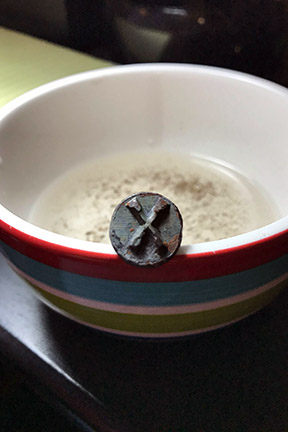
In 1902, the Chicago, Rock Island and Pacific Railroad surveyed the Alex area for placement of a spur that would extend from Chickasha to Lindsay. By 1903, that spur had been constructed and the first trains were running through the area, forever changing it from the lonesome, isolated prairie it had been before.
Long before the advent of computers to keep tabs on track maintenance, railroad men devised a way of marking the wooden ties that supported the tracks as a means of knowing when they might need to be replaced. They drove a short nail (around 2 1/4 inches) with a stamped head into what would be the “face-up” side of the railroad tie. Most often the heads of these machined nails were stamped with numbers like “09” or “37.” These numbers denoted the year the railroad tie was laid with “09” representing 1909 and so forth. Later, the nails were driven into the end of a the railroad tie because so many failed to place the tie “face-up.”
The manufacture of “date nails” was big business in the late 1800s and the first quarter, at least, of the 1900s. Believe it or not, there is a painstakingly researched and free book entitled “Date Nails and Railroad Tie Preservation” that details everything one might want to know about about the origin, date and machining of these nails.
Some railroad companies ordered nails stamped with letters instead of numbers. The letters represented things other than date of the tie into which the nail was driven.
By 1940 or so, the motor car had pretty much replaced rail travel as a primary means of transportation in the area and spur railroad lines were falling into disuse. My grandfather, Earl Manning, and his longtime friend, Johnny Cofer, were two of the Alex men hired to take up the Chicago, Rock Island and Pacific Railroad tracks that ran through Alex. They began removing the tracks and ties in 1941 and completed their job in 1942 or 43. The crew was given the option to purchase the discarded railroad ties on the cheap and my grandfather took advantage, buying several that he would incorporate into corner posts in the fence that enclosed his farm on Roaring Creek near Chitwood.
Today, over 70 years after the railroad ties were pulled up from the Alex area, my brother, Greg Moore, was removing one from a fence on Earl’s farm in anticipation of installing a modern, welded “H-brace.” In the side of the old tie, not at the end, Greg found the nail shown in the pictures below. Stamped with an “X,” the nail’s legend indicates it was driven into a railroad tie treated against weathering with “straight creosote.” I gave the nail a bath in vinegar to reveal the grills and better show the letter stamp. According to the book cited above, the nail was used by the “Chicago” railroad line between 1899 and 1943. It was manufactured by the American Steel and Wire Company, which was later purchased by US Steel.
Seeing as how this nail was found in the side of the railroad tie and not at the end, I would estimate it was used before 1930. Regardless, this simple nail appears to be a genuine, American-made relic of our own bygone age…
